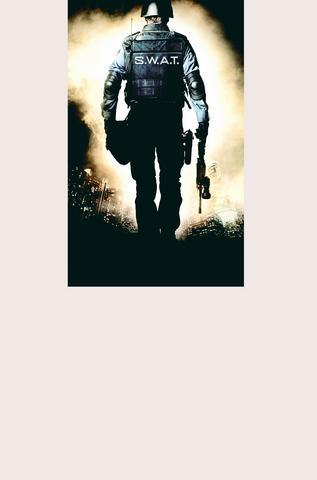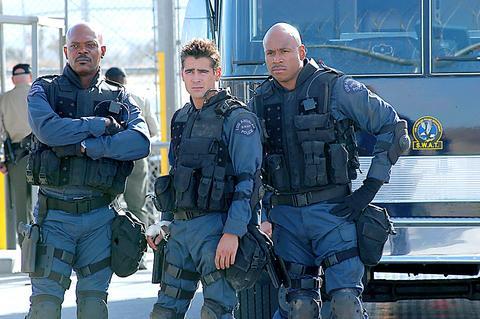The feature-film version of the 1970s cop series SWAT preserves the most memorable thing about the old television show: Barry DeVorzon's wah-wah crackle theme song. (Hearing constant variations on it as arranged by the gifted Elliot Goldenthal is hilarious.) Unfortunately the director, Clark Johnson, and a battery of writers have also retained the punitive monotony and barely coherent narrative thinness of the old show as well. This film evokes the feeling of wasting a rainy Saturday afternoon.
Probably the only reason for trying to make a movie of an old TV show is to utilize its recognition factor while spinning it into something entirely different. And despite Johnson's touching generosity to the old series -- he even gives cameos to Steve Forrest and Rod Perry, two of its stars -- it's not as if anyone had any huge loyalty to the psycho-of-the-week drama of the show. It was just action fodder from Aaron Spelling, the man who was also responsible for Charlie's Angels.

The SWAT film comes armed with a passable paranoid-action-picture premise that, if given the right amount of ferocity, could have played like a remake of Walter Hill's 1979 gangster-lean classic The Warriors. Here the foreign crime boss Alex Montel (Olivier Martinez) -- at least I think that what he's called, since he goes through more identity changes than Elizabeth Taylor -- is about to be extradited after leaving a trail of corpses and misery. Following a failed jail break -- after which Montel inexplicably gets to speak to the TV cameras -- he offers "a hundred meelleeeeon dollars to whoever gets me out of here."

Law in Los Angeles then suddenly evaporates, with all of the city's thugs, gang members and semi-employed, dangerous-looking actors marshaling their forces to spring Montel. An elite SWAT team -- actually, a SWAT unit's SWAT unit -- has to transport this prisoner to a federal pen, the airport or another film remake of an old Aaron Spelling TV show; it's never entirely clear which. But SWAT, which opens in Taiwan today, suffers from a problem of emphasis. The filmmakers have top-loaded the movie with a back story that, sweetly, someone is under the illusion an audience would care about.
The film starts by introducing the Irish actor Colin Farrell -- employing a wobbly American accent that makes him sound like an international criminal a step ahead of the authorities -- as the SWAT officer Jim Street. It's another in his series of conflicted-cop roles; after an involvement with a mission that almost costs a hostage's life, Street is busted down to less glamorous duty.

While putting in his time, he meets Sergeant Hondo Harrelson (Samuel Jackson), who has been charged with assembling a new take-charge SWAT team. And Hondo enlists a group of officers -- Deacon Kaye (James Todd Smith aka LL Cool J), Chris Sanchez (Michelle

Rodriguez), TJ McCabe (Josh Charles) and Michael Boxer (Brian Van Holt) -- so gung ho that in any other city they'd be subjected to steroid testing and probably eliminated from the force. But apparently the streets of Los Angeles call for just such jacked-up action, especially when Montel gently beseeches LA's disenfranchised to set him free.
"Who do we have to paiyyy ..." he snarls to his lawyer. And when she lets him know bribery is out of the question in America, Montel hisses, "Then who do we have to keeeel ..."

The plot organization is meant to play to Johnson's strengths. As a director, his metier is character; he loves actors and has obviously prevailed on Jackson to dial down his patented flourishes. His absurdly named Hondo comes from the old television show (as do Street, Kaye and McCabe). Jackson's Rhythm Heritage confidence brings to mind the burbling funk of the SWAT theme song.
The director shows a marrow-deep confidence, too, on occasion in the scenes with the actors gabbing and getting to know one another, letting their defenses down. Yet the performances aren't informed by the affection he has for his cast.
As an actor Johnson was a regular on the television series Homicide, he and Jon Polito were the first characters heard, and their goony squabbling set the tone for the show. There's no dialogue here as good as their arguing over Lincoln's assassination; much of the talk in this SWAT seems to have been lifted verbatim from crummy 70s cop shows or The Facts of Life. McCabe informs a date, "I may work in the mud, but I certainly like to play in the clouds."
Certainly Johnson doesn't have a real taste for action; much of the by-the-yard martial choreography is strictly by the book, as Hondo's martinet captain might say. The director almost seems to be rejecting the movie's right-wing politics, and his discomfort is palpable, like Danny Glover's slight hesitations in the Lethal Weapon movies.
SWAT is mostly standard-issue muddle, right down to setting a crucial sequence in the Los Angeles subway. Most Angelenos probably think the subway was built for film crews; it's used more in the movies than in real life. And the underground scene takes so long, you may start to wonder if the cast will emerge in another Aaron Spelling product, Fantasy Island. That would make sense, since this movie is as natural as the virgin polyester fibers in Ricardo Montalban's suits.

The canonical shot of an East Asian city is a night skyline studded with towering apartment and office buildings, bright with neon and plastic signage, a landscape of energy and modernity. Another classic image is the same city seen from above, in which identical apartment towers march across the city, spilling out over nearby geography, like stylized soldiers colonizing new territory in a board game. Densely populated dynamic conurbations of money, technological innovation and convenience, it is hard to see the cities of East Asia as what they truly are: necropolises. Why is this? The East Asian development model, with

June 16 to June 22 The following flyer appeared on the streets of Hsinchu on June 12, 1895: “Taipei has already fallen to the Japanese barbarians, who have brought great misery to our land and people. We heard that the Japanese occupiers will tax our gardens, our houses, our bodies, and even our chickens, dogs, cows and pigs. They wear their hair wild, carve their teeth, tattoo their foreheads, wear strange clothes and speak a strange language. How can we be ruled by such people?” Posted by civilian militia leader Wu Tang-hsing (吳湯興), it was a call to arms to retake

This is a deeply unsettling period in Taiwan. Uncertainties are everywhere while everyone waits for a small army of other shoes to drop on nearly every front. During challenging times, interesting political changes can happen, yet all three major political parties are beset with scandals, strife and self-inflicted wounds. As the ruling party, the Democratic Progressive Party (DPP) is held accountable for not only the challenges to the party, but also the nation. Taiwan is geopolitically and economically under threat. Domestically, the administration is under siege by the opposition-controlled legislature and growing discontent with what opponents characterize as arrogant, autocratic

When Lisa, 20, laces into her ultra-high heels for her shift at a strip club in Ukraine’s Kharkiv, she knows that aside from dancing, she will have to comfort traumatized soldiers. Since Russia’s 2022 invasion, exhausted troops are the main clientele of the Flash Dancers club in the center of the northeastern city, just 20 kilometers from Russian forces. For some customers, it provides an “escape” from the war, said Valerya Zavatska — a 25-year-old law graduate who runs the club with her mother, an ex-dancer. But many are not there just for the show. They “want to talk about what hurts,” she